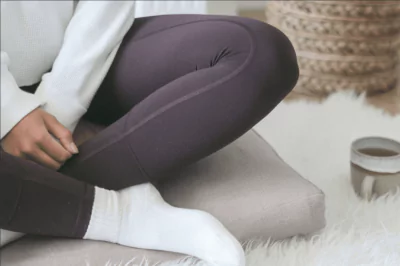Table of Contents[Hide][Show]
Maybe you’ve seen #EffYourBeautyStandards or #CelebrateMySize under a beautiful picture of a full-bodied woman rocking the heck out of her curves and popping her hips on Instagram. And maybe that got you through a tough day.
Or maybe you’ve turned to your explore page to find some ‘Instagram vs Reality’ photos after scrolling through too many edited model shots that have you questioning whether ribs were removed in the making of the photos.
Most of us have encountered the Body Positive Movement in little ways on social media, but body positivity is so much more than uplifting tweets and anti-transformation photos.
What exactly is the body positive movement?
It started as an offshoot of the fat acceptance movement and has grown into a force of its own. Second wave feminism brought with it an acceptance of all body sizes as a protest to unrealistic body standards. The fat acceptance movement was dedicated to correcting fat-shaming and changing the belief that fat is synonymous with unhealthy.
Beginnings of the movement
In 1996, Licensed Clinical Social Workers, Connie Sobczak and Elizabeth Scott created The Body Positive organization after Connie’s sister died from complications caused by an eating disorder. The organization provides resources for anyone struggling with their body image and seeks to help women focus on pursuing their dreams rather than degrading their bodies.
Nowadays, The Body Positive Movement is all-encompassing, centering around rethinking the beauty standards we’ve been subjected to for years and loving all bodies, no matter the gender, race, size, or any other specifications society has traditionally told us are less beautiful (read: important).
How this movement is changing the world
The Body Positive Movement has been widely embraced and each demonstration is as unique as the voice that carries it. Since the movement is working towards acceptance of all bodies it takes on as many different forms as there are people on this earth.
Who’s embracing body positivity?
We’ve seen celebrities like Alicia Keys and Jennifer Garner tout the movement by going makeup-free to protest the unrealistic expectations of flawless skin and promote accepting your bare self.
Erika Hart—breast cancer-warrior, activist, and sexuality educator—takes on the body positive message by freely modeling topless, emphasizing the fact that a double mastectomy does not take away your sexuality and self-love.
Tess Holiday, a self-proclaimed fat girl and author of The Not So Subtle Art of Being a Fat Girl, created the #EffYourBeautyStandards movement and supports the complete rejection of societal norms with her unapologetic (and completely badass) diva demeanor and artistic pin-up modeling. Both her and Hart use social media as a platform for their message and take their followers through their ups and downs of their journeys with honesty and openness.
As more and more women are inspired by the rejection of the current cookie-cutter (and lame) beauty standards, our media becomes more inclusive.
Why representation matters
On a larger scale, this movement is about loving yourself and everyone else for what’s inside (cue rainbows and butterflies). But really, when we accept all bodies as beautiful, we find ourselves looking past skin color and outward religious symbols to normalize people from every walk of life.
When a child grows up seeing Erika Hart on the cover of Cosmopolitan, her idea of beauty is shaped to be more inclusive, rather than limited to the bleached heroine chic models of our past.
This next generation of females will be the most expressive and impressive because they are daring to thrash the white veil covering their eyes and explore the vivid palate the world has offered them.
4 steps to be more body positive (for yourself)
1. curate your feed
Customize your social media to support your view of body positivity. With all the algorithms we pretend to understand and eerie ads relevant to your latest conversation, it’s clear our social media is listening and reacting to us.
Our explore page is populated based on what we show to be our interests. The best thing you can do for yourself is stop following clothing lines, models, influencers, bikini brands… anything that makes you look at your phone then look down at your VERY NORMAL stomach rolls and think those shouldn’t be there.
When you stop surrounding yourself with unrealistic beauty standards you’d be surprised how much your perspective changes.
On top of that, you should follow anyone who you think will inspire you to love yourself. This can be brands with inclusive models, diva influencers who don’t care what people think, or maybe even a motivational quote page.
2. Use body positive language
Use body positive language. This can mean different things for different people. Take Tess Holiday for example—she ripped on a woman interviewing her who tried to comfort her by telling Holiday, “You’re not fat.” Holiday wears the term ‘fat’ like a badge of honor and she works to battle the stigma. So for Holiday “fat” doesn’t carry the shame it does for most people.
For others it’s more subtle. Make a mental note of the way you talk to yourself. If you wouldn’t say it to your friend, don’t say it about yourself. We’re often our own worst critics, but part of being body positive is moving into a place where you can acknowledge those feelings, let them pass without judgement, and correct them to show yourself love.
3. Show yourself some self love
Appreciate your body for what it has done for you and can do. We spend most of our time asking ourselves why our waistline doesn’t look like Kylie Jenner’s or our hair isn’t as long as Becky’s from Chem class. Don’t compare. Easier said than done, I know, but a nice tactic to take when you notice you’re wishing for someone else’s anything is to list the reasons why you appreciate your body.
That doesn’t mean what physical features you like about yourself. It means make a list of accomplishments that wouldn’t have been possible if you were anyone but yourself. It was your legs that carried you across the finish line of the 100 meter dash. And it was your fingers that played the piano at your sister’s wedding. Andddd it was your brain sitting under your head of hair that made the barista smile the other day with that hilarious joke.
The more often you give yourself a mental hug, the more you let go of that internal self-disparaging conflict.
4. get rid of the scale, if you think you need to
Get rid of the scale (if you’re about that). Even though the Body Positive Movement is so much more than your pant size, this is still a major part of it for a lot of people. Those who don’t have a condition that requires regular weigh-in’s should consider ditching the bathroom scale. Instead of counting lb’s, try assessing how you feel. Do you feel healthy? Are you happy? Then who cares what the scale says.
I know that for most of us it’s not as simple as that. But for those who have the ability to move away from quantifying our bodies by size, this is a really good place to start. When you listen to your body, it will tell you what you need.
4 steps to be more body positive (for the world!)
1. foster inclusivity in your workplace
If you are in any decision making role, dare to explore options outside the traditional (read outdated) standards. Hi you, yes you, want to get ahead in your career while also making the world a better place?
Be all-inclusive to promote body positivity. If you continue using the stale white-bread models (who would demand a lettuce wrap substitute) to represent your brand, your message will be pigeonholed and fade into the other fifty shades of beige.
The world is forever growing smaller as our population grows bigger and technology has us all linked by our scrolling fingers. People will be drawn to a company they can relate to. Widen your audience with body positive branding—it’s seriously just good business.
2. rethink your compliments
Learn to give compliments about things other than appearance. This one is harder than it sounds. It’s not until you see a little girl in a princess tutu that you realize how often we validate people based on clothes and appearances (especially children).
Instead of telling the adorable princess how pretty her sparkling dress is, ask her a question about her life and then find something to compliment based on her interests. This applies to adults as well. Look to compliment the way people live their lives.
Not only does this help with body positivity, but it’s also much more meaningful. Wouldn’t you rather hear “the rad braid you put your hair in is really inventive” rather than “your eyes are soo beautiful and blue.” Thanks, I worked really hard on them….
3. practice patience and empathy
Be patient and supportive with friends suffering. When you have a friend who doesn’t see her full potential like you do, it can be hard to be sympathetic. But we’re in the business of empathy not sympathy, so try to jump in her shoes and genuinely understand her struggle.
Build your friend up using body positive language and always be there for them in whatever way they specifically need. Most of the time that will involve patience. Don’t snap at them when they get down on themselves about their body image.
My favorite thing to do is say, “Please don’t talk about my friend that way.” This reminds them 1) they are deeply loved and supported; 2) they have someone on their team; 3) they are being their own worst enemy in that moment.
4. put your money where your mouth is
Support brands supporting the cause. Do your research and put some power behind your penny. You have more control than you think. Every time you make a purchase you are validating that company. Some companies that support diverse bodies are Aerie, ModCloth, NeonMoon, BedHead, SmartGlamour… the list goes on and on.
I promise it won’t be hard to find body positive companies you like. So, make the choice to give your money to companies that preach self-love and body positivity. Other brands will catch on and hopefully, soon enough, every woman will feel represented.








What steps have you taken to be more body positive in your own life? Share in the comments!